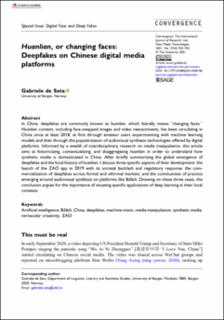Huanlian, or changing faces: Deepfakes on Chinese digital media platforms
Journal article, Peer reviewed
Published version

Åpne
Permanent lenke
https://hdl.handle.net/11250/2833613Utgivelsesdato
2021Metadata
Vis full innførselSamlinger
Originalversjon
Convergence. The International Journal of Research into New Media Technologies. 2021, 27 (4), 935-953. 10.1177/13548565211030185Sammendrag
In China, deepfakes are commonly known as huanlian, which literally means “changing faces.” Huanlian content, including face-swapped images and video reenactments, has been circulating in China since at least 2018, at first through amateur users experimenting with machine learning models and then through the popularization of audiovisual synthesis technologies offered by digital platforms. Informed by a wealth of interdisciplinary research on media manipulation, this article aims at historicizing, contextualizing, and disaggregating huanlian in order to understand how synthetic media is domesticated in China. After briefly summarizing the global emergence of deepfakes and the local history of huanlian, I discuss three specific aspects of their development: the launch of the ZAO app in 2019 with its societal backlash and regulatory response; the commercialization of deepfakes across formal and informal markets; and the communities of practice emerging around audiovisual synthesis on platforms like Bilibili. Drawing on these three cases, the conclusion argues for the importance of situating specific applications of deep learning in their local contexts.
